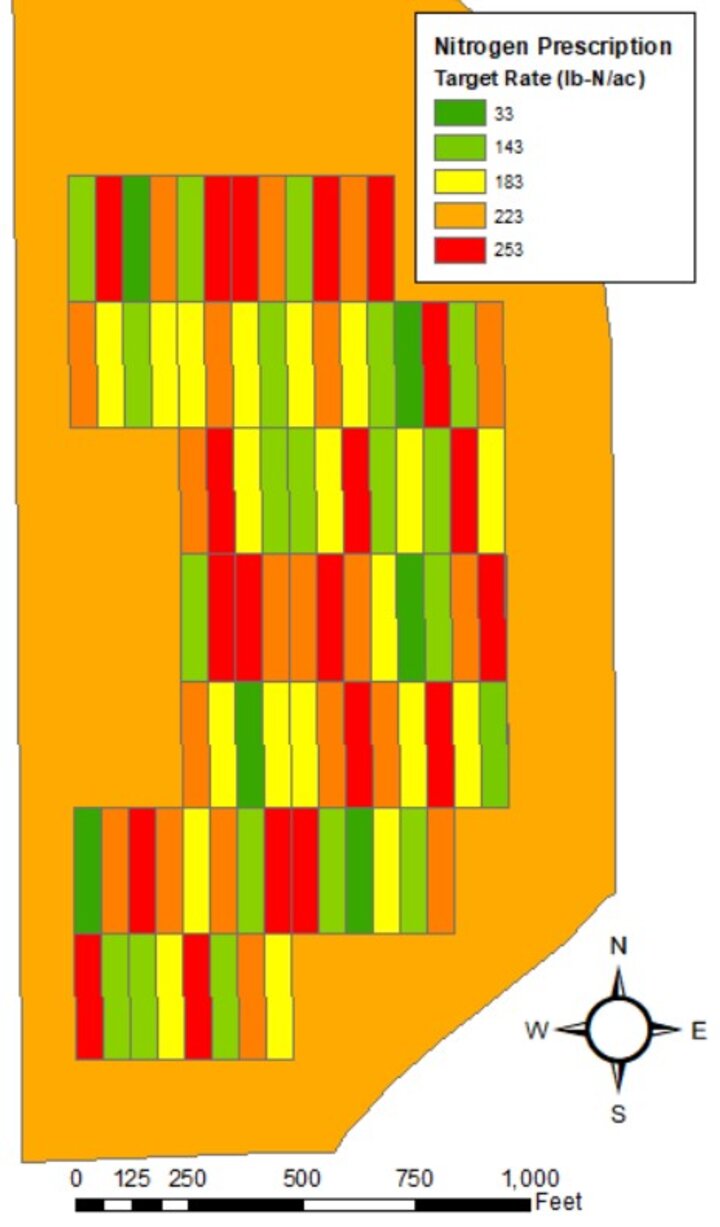
Knowing how much nitrogen (N) to apply to corn is challenging. This year, the wet, rainy weather has only made the situation more complicated. If additional N is applied, it’s often difficult at the end of the year to know how an N tool or strategy performed. Setting up an on-farm research test can help you validate and refine your N management approaches. There are many resources available to help you set up an on-farm research study to evaluate your in-season N management. In this article we present research protocols and results for several N studies conducted by farmers participating in the Nebraska On-Farm Research Network.
Checkerboard Block Nitrogen Rate Trials
Over the past few years, growers have been using prescriptions to test various N rates across their fields. This research layout allows growers to test various rates (either pre-plant or in-season), determine the economic optimum N rate, and determine how N response varied across the field.
Pre-plant Nitrogen Rate Block Study in 2018
A site in Hamilton County was completed in 2018. This site followed the checkerboard approach where all the N was applied pre-plant. A total of 33 lb N/ac was applied to the whole field with applications of 250 lb/ac 11-52-0 and 5 gal/ac 10-34-0 starter fertilizer. The N rate treatments were established with an anhydrous ammonia application on March 30. Rates of 0, 110, 150, 190, and 220 lb N/ac were applied to equal total treatment rates of 33, 143, 183, 223, and 253 lb N/ac shown in Figure 1.
At this site, the economic optimum N rate for the entire field was 177 lb/ac, resulting in a yield of 283 bu/ac (assumes $3.23/bu corn selling price and $0.35/lb N fertilizer cost). The resulting N use efficiency at that rate was 0.63 lb-N/bu-corn! The economic optimum N rate for several scenarios is shown in Figure 2. The economically optimum N rate for this field was substantially lower than the grower’s traditional N management, presenting an opportunity to reduce N rates.

The full research report for this study is available online.
While nitrogen in this particular study was applied pre-plant, the same technique can be applied with an in-season application. If you are interested in conducting a similar checkerboard trial by establishing different in-season N rate blocks, contact Joe Luck (jluck2@unl.edu) for assistance in setting up a prescription.
Field-length Strip Nitrogen Rate Trials
Field-length strip trials are also a great way to evaluate an N management strategy and do not require the development of a prescription or variable rate fertilizer equipment capabilities.
Side-dress Nitrogen Rate Field-length Strip Study in 2017
A 2017 study in Dodge County evaluated four N management strategies:
- Pre-plant (210 lb N/ac applied pre-plant)
- Sidedress (70 lb N/ac applied pre-plant + 140 lb N/ac sidedress)
- Sidedress minus 30 (70 lb N/ac applied pre-plant +110 lb N/ac sidedress)
- Sidedress plus 30 (70 lb N/ac applied pre-plant + 170 lb N/ac sidedress)
The research study utilized field-length strips as shown in Figure 3.
Across the entire field, the sidedress treatments resulted in greater yield and greater marginal net return than the pre-plant N management (Table 1).
| Yield (bu/ac)† | Marginal Net Return‡ ($/ac) | |
|---|---|---|
| Pre-plant (210 lb N/ac Pre-plant) | 216 B* | 610.98 B |
| Sidedress (70 lb N/ac Pre-plant + 140 lb N/ac Sidedress) | 243 A | 689.43 A |
| Sidedress minus 30 (70 lb N/ac Pre-plant + 110 lb N/ac Sidedress) | 239 A | 684.90 A |
| Sidedress plus 30 (70 lb N/ac Pre-plant + 170 lb N/ac Sidedress) | 251 A | 704.07 A |
| P-Value | 0.0007 | 0.0009 |
† Bushels per acre corrected to 15.5% moisture. | ||
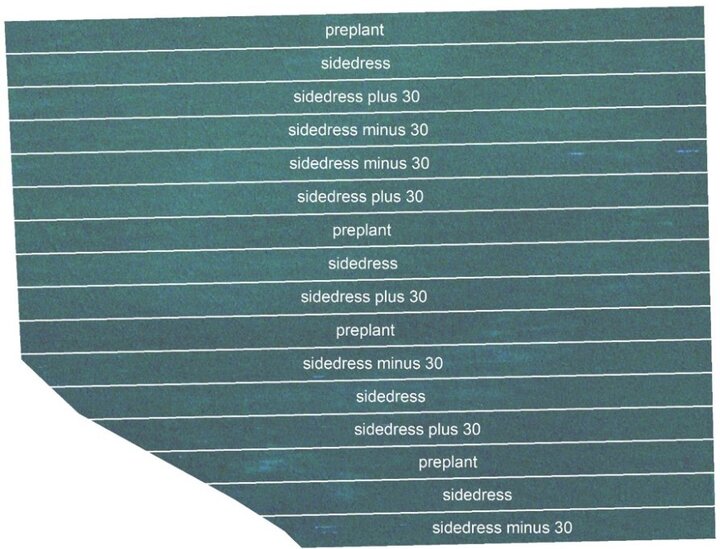
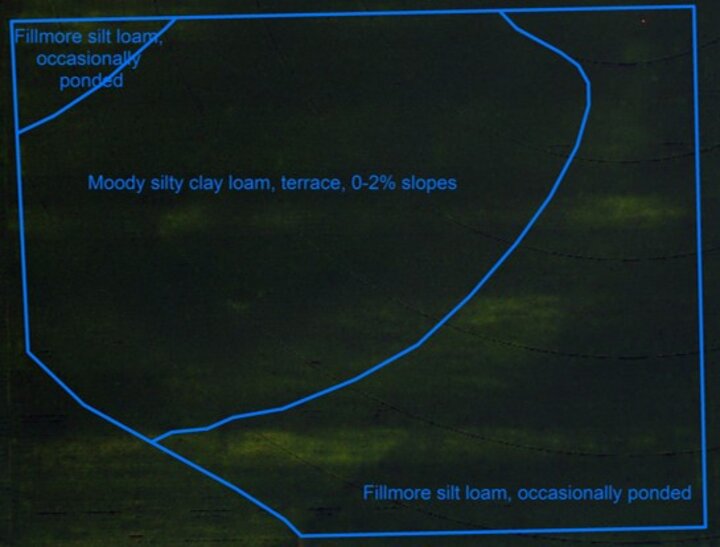
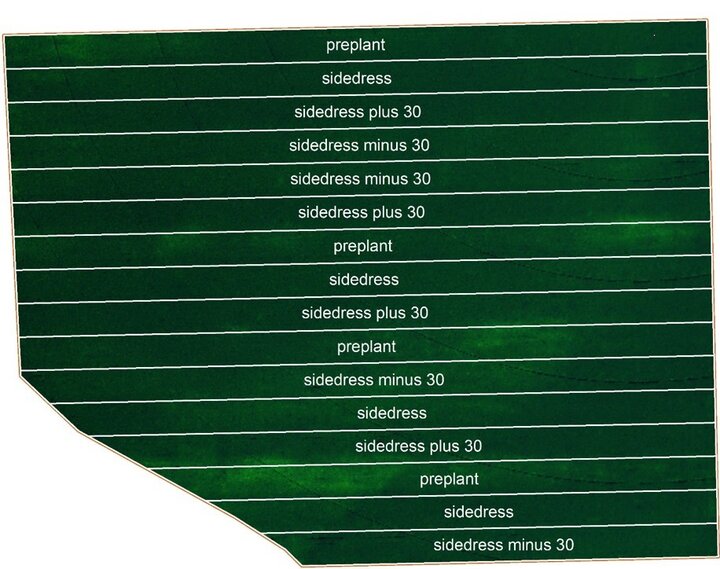
However, soil types in this field are variable, consisting of Moody silty clay loam and Fillmore silt loam, occasionally ponded. Aerial imagery from August 31, 2017 revealed that portions of the field in the Fillmore silt loam, occasionally ponded soil were lighter yellow and exhibiting N deficiency (Figure 4).
Overlaying the treatments on this image (Figure 5) revealed that the N deficient areas within the Fillmore silt loam, occasionally ponded soil corresponded to the pre-plant N treatment. An analysis of the yield within the Fillmore silt loam soil showed that the sidedress treatment with 70 lb N/ac pre-plant and 140 lb N/ac sidedress (210 lb N/ac total) resulted in a yield of 239 bu/ac compared to the pre-plant only treatment (210 lb N/ac total) with a yield of 206 bu/ac. In this portion of the field, split applying the same rate of N resulted in a 33 bu/ac yield advantage.
The full research report for this study is available here: http://resultsfinder.unl.edu/assets/pdfs/004053201701_N_Rate.pdf
Side-dress Nitrogen Tool Field-length Strip Study in 2016
A 2016 field length strip study in Dodge County evaluated a commercially available nitrogen management tool, Climate FieldView™ Nitrogen Advisor. This tool uses a process model that takes into account the major physical, chemical, and biological processes that affect nitrogen in agricultural fields. This study took place on Kennebec silt loam, Zook silt loam, Zook silty clay loam, and Alcester silty clay loam soils in a corn following corn rotation. The whole field received 75 lb N/ac applied as 32% UAN with herbicide and 5 gal/ac 6-24-6 as starter. The Climate FieldView™ tool was used to determine an in-season N recommendation. The tool recommended 65 lb N/ac be applied during the growing season. The sidedress application was made on June 11. Three treatments were evaluated:
- Climate FieldView rate (65 lb N/ac)
- Climate FieldView rate minus 30 lb (35 lb N/ac)
- Climate FieldView rate plus 30 lb (95 lb N/ac)
The study found there were no statistical yield differences between the treatments. The Climate FieldView rate minus 30 yielded 196 bu/ac, and both the Climate FieldView rate and Climate FieldView rate plus 30 yielded 201 bu/ac. This indicates that the lowest N rate tested would have been sufficient. For reference, the recommended nitrogen rate using the UNL N rate calculator (pre-season model) was 136 lb N/ac and the Climate FieldView total rate was 142 lb N/ac for the season. Therefore, both the UNL N rate and Climate FieldView rate were comparable in their N recommendation.
The full research report for this study is available here: http://resultsfinder.unl.edu/assets/pdfs/359053201601_Climate_FieldView_Corn.pdf
You may also be interested in a similar study evaluating Climate FieldView in a corn following soybean rotation: http://resultsfinder.unl.edu/assets/pdfs/359053201602_Climate_FieldView_Corn_after_Beans.pdf
Nitrogen Trials on Contour Farmed Fields
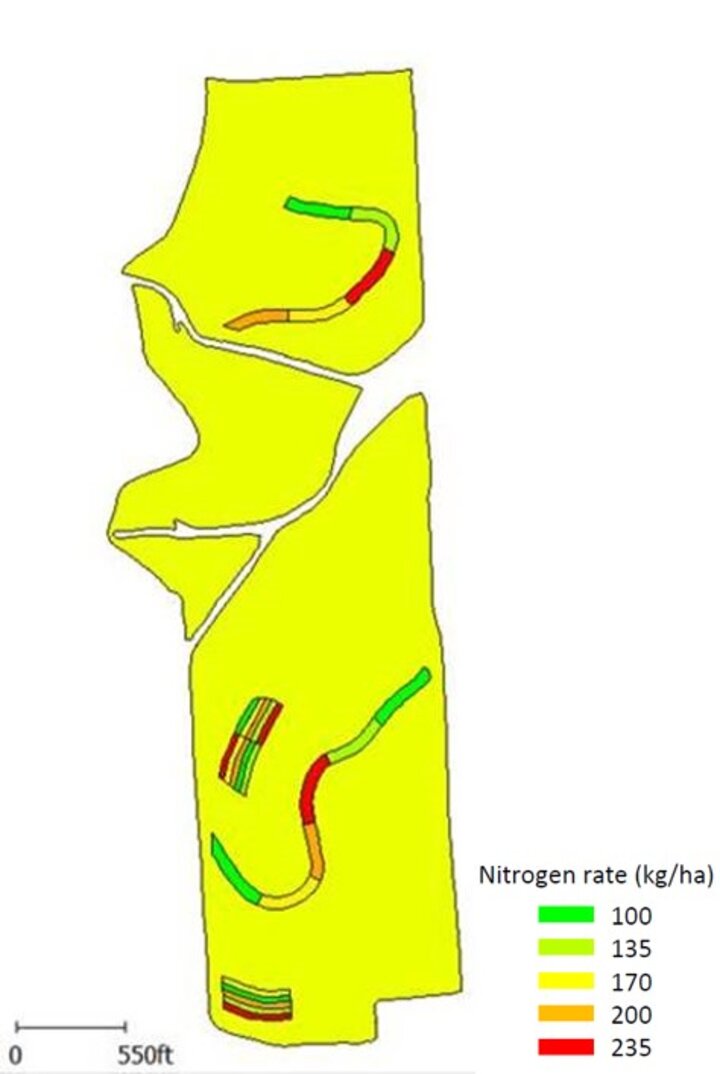
For fields that are farmed on a contour, a different approach may be needed. Similar to the checkerboard approach, this trial relies on developing a research prescription and using variable rate fertilizer equipment to establish varying rates of N. In the example in Figure 6, several rates were applied with the direction of contour fertilizing and planting with terraces. Following N application, the as-applied data will be evaluated for accuracy. At harvest, yield data collected with a yield monitor will be used to extract yield data points corresponding spatially to areas receiving the target N rate. In this study, the rate blocks will be monitored throughout the growing season via airplane, satellite, or drone imagery. If lower N rate blocks begin to show N deficiency, additional N applications can be made. This study demonstrates how precision ag technologies may be used to conduct on-farm research on fields that typically are not used for on-farm research studies.
There are several past studies using aerial-applied nitrogen. Learn more by reading the following reports:
- http://resultsfinder.unl.edu/assets/pdfs/416147201701_Drone_Nitrogen_SARE.pdf
- http://resultsfinder.unl.edu/assets/pdfs/0416147201801_DroneBasedSensorsVariableRateInSeasonNitrogenCorn.pdf
- http://resultsfinder.unl.edu/assets/pdfs/0810147201801_DroneBasedSensorsVariableRateInSeasonAerialNitrogenApplicationCorn.pdf
Research Protocols for Evaluating N Management Tools
You can conduct your own similar research to evaluate and refine N management on your fields. Several research protocols (https://cropwatch.unl.edu/farmresearch/extensionprotocols) have been developed to assist with evaluating N management strategies and tools. These protocols can be adapted as needed, or new protocols can be developed to meet your needs. Contact your local extension educator or the Nebraska On-Farm Research Network coordinators to learn more.
- Evaluating Sidedress Nitrogen Decision Tools
- Maize-N Sidedress vs. Producer N Sidedress
- PSNT-N +/-30 lb N/ac at Sidedress
- UNL Corn Nitrogen Recommendation +/- 30 lb N/ac at Sidedress
- UNL Nitrogen Calculator Spreadsheet
More on N Management
For additional N management strategies to consider, review this article from last week’s CropWatch: https://cropwatch.unl.edu/2019/season-nitrogen-management-corn-2019

